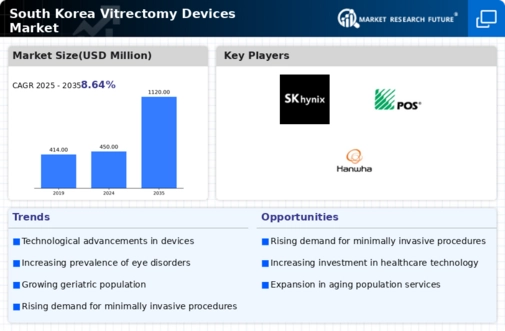The South Korea Vitrectomy Devices Market has emerged as an essential segment within the ocular healthcare industry, characterized by a competitive landscape that is continuously evolving. With an increasing prevalence of retinal disorders and advancements in eye surgeries, the demand for vitrectomy devices has witnessed significant growth. This market is characterized by various players that contribute to an innovative range of surgical instruments, enabling complex eye surgeries to be performed more efficiently and safely. The competitive dynamics are shaped by technological advancements, strategic partnerships, product launches, and the need for high-quality and precise instruments within South Korea's healthcare infrastructure.
The presence of both established and emerging players adds to the competitive vigor, as they strive to capture market share by focusing on research and development and leveraging local market needs.In the context of the South Korea Vitrectomy Devices Market, Topcon stands out as a prominent player that has made substantial inroads. Known for its advanced ophthalmic technologies, Topcon has solidified its strengths through a robust portfolio of vitrectomy solutions that cater specifically to the needs of eye care professionals in South Korea.
The company's emphasis on precision and innovation allows it to introduce cutting-edge devices that enhance surgical outcomes for retinal surgeries. Furthermore, Topcon has leveraged strategic partnerships with local hospitals and clinics, ensuring its products are accessible and integrated within the existing healthcare ecosystem. The company's commitment to customer support and post-operative care has also enhanced its reputation among practitioners, thereby fortifying its market presence.Optos, another key player within the South Korea Vitrectomy Devices Market, focuses on providing high-resolution imaging solutions that are integral to effective vitrectomy procedures.
The company's signature products include advanced retinal imaging devices that enable detailed visualization of the eye's interior, which can significantly improve surgical planning and execution. Optos's market presence in South Korea is fortified by its collaboration with healthcare professionals and institutions, ensuring the continued dissemination of its innovative technologies. The company's strengths include a strong focus on research and development, leading to continuous refinement and enhancement of its product offerings. Additionally, Optos has engaged in strategic mergers and acquisitions that have expanded its technological capabilities and market reach in South Korea, positioning it favorably against competitors.
Overall, the company is well-regarded for its commitment to improving patient outcomes through advanced technology in the vitrectomy space.














Leave a Comment